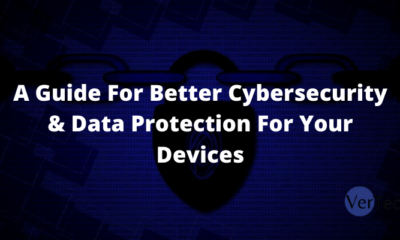Tech
Mitigating Malware and Ransomware Attacks

Cyber threats such as malware and ransomware have reached unprecedented levels of sophistication, targeting organizations of all sizes and industries. The ramifications of these malicious entities can be devastating, leading to data breaches, financial losses, and reputational damage. Mitigating the impact of malware and ransomware attacks is paramount for organizations seeking to safeguard their critical assets and maintain business continuity.
In this blog post, we present actionable tips and best practices to not only deal with the effects of these attacks but also prevent malware infections and respond effectively if already infected.
Preventing Malware Infections: A Proactive Defense
Explore actionable strategies and best practices to fortify your organization’s defenses against malware, empowering you to stay one step ahead of evolving cyber threats.
Here are six best practices to proactively prevent cyberattacks:
- Implement robust endpoint protection solutions
The first line of defense against malware is deploying robust endpoint protection solutions. This includes antivirus and anti-malware software capable of detecting and neutralizing a wide range of threats. Regularly update and scan all devices to ensure they are shielded from the latest malware variants.
- Stay current with patch management
Vulnerabilities in outdated software and operating systems are prime targets for malware exploits. Regularly update and patch software to close security loopholes and strengthen your network’s resilience against potential attacks.
- Adopt network segmentation
Network segmentation is a proactive measure that limits the lateral movement of malware within your infrastructure. By dividing your network into smaller, isolated segments, you can contain the spread of malware, thereby minimizing potential damage and data loss.
- Prioritize email security
Phishing remains a favored technique for spreading malware. Prioritize email security by employing advanced filtering systems to detect and block malicious attachments and phishing attempts. Additionally, educate employees about the risks associated with clicking on suspicious links or downloading files from unknown sources.
- Utilize web filtering
Web filtering is an effective measure to prevent users from inadvertently accessing malicious websites. Implementing web filtering tools helps block access to websites known for hosting malware, reducing the likelihood of infection.
- Practice least-privilege access
Implementing the principle of least privilege ensures that users are granted access only to the resources essential for their roles. By restricting privileges, organizations minimize the potential damage and lateral movement of malware within the network.
Responding To Malware And Ransomware Incidents: Swift Action Is Key
To protect your organization’s network, it’s important to delve into the critical steps and best practices for effectively mitigating the impact of malware and ransomware attacks, emphasizing the importance of rapid incident response to safeguard your organization’s assets and data.
These are five best practices for responding to breaches:
- Isolation and containment
If a malware infection is detected, immediate action is crucial. Isolate the affected device or network segment to prevent the spread of malware within your infrastructure. This containment measure helps mitigate the impact and allows for focused incident response efforts.
- Develop an incident response plan
An incident response plan is a critical component of your organization’s cybersecurity strategy. It should outline step-by-step actions to be taken when a malware or ransomware attack is suspected or confirmed. The plan should define clear roles, responsibilities, communication protocols, and escalation procedures.
- Regular and secure data backups
In the unfortunate event of a ransomware attack, having regular and secure backups of critical data is a lifesaver. Maintaining up-to-date backups allows for quick data restoration without succumbing to ransom demands.
- Conduct forensic analysis
Understanding the attack vector and infection vector is crucial in strengthening your defenses against future threats. Conduct thorough forensic analysis to determine the scope and impact of the malware attack, enabling your organization to bolster its security posture.
- Collaborate with law enforcement
Report the malware or ransomware incident to law enforcement agencies and cybersecurity authorities promptly. Collaboration with these agencies can lead to valuable intelligence gathering and potentially aid in apprehending the perpetrators.
Navigating Ransomware Attacks: Steps To Take If Infected
In these five best practices, we provide essential guidance on responding to ransomware incidents to effectively handle and recover, ensuring minimal disruptions to your organization’s operations and data security.
- Refrain from paying ransom
In the face of a ransomware attack, it may be tempting to pay the ransom to regain access to encrypted data. However, paying the ransom does not guarantee the attackers will provide the decryption key. Furthermore, funding ransomware operations perpetuates the ransomware economy.
- Isolate infected devices
Immediately isolate the infected device or network segment to prevent further spread of the ransomware. Quick action can help contain the infection and limit damage.
- Report the incident
Report the ransomware attack to law enforcement agencies, providing them with relevant information for their investigations.
- Restore from backups
After isolating the infected devices, restore data from secure backups to minimize data loss and restore operations as swiftly as possible.
- Reinforce network defenses
Once the organization has recovered from the ransomware attack, it is crucial to reassess and reinforce network defenses. Updating software, implementing the latest security measures, and conducting ongoing security awareness training help minimize the risk of future attacks.
By following these best practices and staying vigilant, organizations can navigate the ever-changing threat landscape and fortify their digital fortresses against the menace of malware and ransomware attacks. Together, we can foster a secure and resilient digital future, safeguarding our invaluable data and preserving the trust of stakeholders.
-
Blog1 year ago
MyCSULB: Login to CSULB Student and Employee Portal – MyCSULB 2023
-
Android App3 years ago
Cqatest App What is It
-
Android1 year ago
What Is content://com.android.browser.home/ All About in 2023? Set Up content com android browser home
-
Software2 years ago
A Guide For Better Cybersecurity & Data Protection For Your Devices
-
Latest News2 years ago
Soap2day Similar Sites And Alternatives To Watch Free Movies
-
Android2 years ago
What is OMACP And How To Remove It? Easy Guide OMACP 2022
-
Android3 years ago
What is org.codeaurora.snapcam?
-
Business2 years ago
Know Your Business (KYB) Process – Critical Component For Partnerships





















